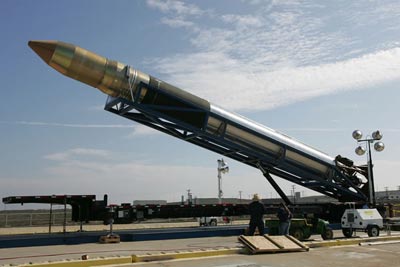Vote yes on Prop 2001by Sam Dinkin
|
|||||||||||||||||||||||||||||
| California may win the next space race with SpaceShipOne, Falcon 5, and Xerus the way California’s Apple and Intel supplanted New York’s IBM. |
Of course, non-destructive stem cell line creation would increase the cost and reduce the efficacy of stem cell production so pro-research folks would balk. Most genetic screening results in embryos that are discarded if they don’t pass muster so the anti-stem cell research lobby would certainly find fault with my technical tightrope walking. I guess I can find solace in the fact that both sides usually hate great policy.
As sex selection radically alters China and India in a single generation, perhaps we can see California’s novel initiative radically altering the opportunity for research and development of space. California likes to brag that it has the fifth largest economy in the world. By my math, California would have the sixth largest economy in the world by $25 billion if you count Germany, France, UK and Italy as one economy. However, if you look at these 11 economies, you find all of the major space powers. The US certainly spends the most, but California with its cool designers may win the next space race with SpaceShipOne, the Falcon 5, and Xerus the way California’s Apple and Intel supplanted New York’s IBM. That may take a big dollar commitment, though, from a state to create a third-generation space industry.
| US | $11 trillion |
| China | $6.4 trillion |
| Japan | $3.6 trillion |
| India | $3 trillion |
| Germany | $2.3 trillion |
| France | $1.7 trillion |
| UK | $1.7 trillion |
| Italy | $1.6 trillion |
| California | $1.4 trillion |
| Brazil | $1.375 trillion |
| Russia | $1.3 trillion |
| Source: CIA World Factbook (2003 est.) | |
A $3 billion initiative on stem cell research is big bucks for a state, but a similar level of financing may be enough to launch a new space industry. California does not get to keep the bulk of its citizens’ tax revenues. California’s budget total for 2004-2005 not including federal funds is $105 billion. $300 million a year for ten years represents 0.29% of the state’s budget for those years.
| States may become embroiled in a race to space. |
If you look at NASA’s share of the federal budget, which runs at about 1%, it is not inconceivable that Sacramento could fund space to the tune of $10 billion over ten years and launch the first Mars mission, Hollywood-style. Have mission control in Pasadena, a nuclear engine from Livermore, and launch from Mojave. (Can you scrape up enough support to get an initiative on the ballot, Bob?)
Oklahoma and New Mexico are bearing down on space tourism. A $30 million commitment from Oklahoma is equivalent to a more than a $300 million commitment from California because Oklahoma’s gross state product is close to $100 billion. So we are already more than 1% of the way there—don’t laugh, it’s that first step that’s a doozy.
States may become embroiled in a race to space. This may be a true race to the top as states jockey for which will be the home to tourism, travel agencies, industrial production, support, teleoperation, robotics, finance, and legal. The fight in a couple of decades will make the rush to site car plants look like child’s play. There is, however, a huge first mover advantage to the state that takes up the gauntlet left on the Moon so many years ago by President Nixon. That state may win a race with GDP chart movers China, India, and Brazil to become the progenitor of the most important new branch of humanity. And if my guess is right, that branch won’t just consist of stem cells.
